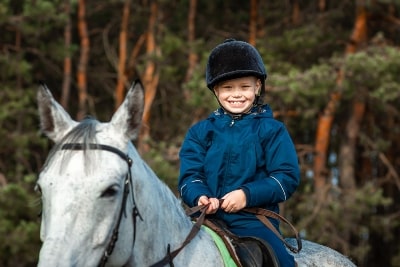Horse Tips For Kids
** Affiliate disclosure. This web site is supported by its awesome audience. When you click or purchase through links on our site, we may earn an affiliate commission.

If you’re thinking of getting your kids involved with horses, there are some things that you need to know. Horses are a great way to teach your children about responsibility, perseverance and leadership.
Before your child can ride, they should learn all the basics such as ground work, grooming and handling. Taking lessons will help them learn these skills quickly.
1. Always wear a helmet
Horse riding is a great activity for kids, but it can also be very dangerous. Head injuries can cause permanent brain damage and even death.
This is why it’s important to always wear a helmet when riding your horse. It doesn’t matter how experienced you are or how close your relationship is with your horse, you can still make a mistake that could lead to injury.
When it comes to equestrian safety, the most common injury is a head injury. The human skull can shatter on an impact of 7 to 10 kilometres per hour, and horses gallop at over 65 kph.
Fortunately, most head injuries can be prevented by wearing and properly fitting an ASTM or SEI approved helmet. Helmets should fit snugly and comfortably to encourage maximum wear and protection.
2. Keep your hands off the ground
When your horse becomes frightened by something or a loud noise, the most effective way to calm it is to keep your hands off the ground. When your hands are in contact with the ground, the horse may try to run or fight against you.
Riding is an incredibly sensitive skill, and you must have good control of your body, seat and hands to stay safe. To achieve this, you must practice often.
Hands should be 4-5 inches apart and soft and elastic in your shoulders, elbows and wrists to follow the horse’s mouth smoothly and communicate with it effectively.
If you are riding in a circle, your reins should never touch the horse’s neck; this is how you create the proper line between your arm and his mouth.
If your hands are too wide, your forearm will break this line and reduce the effectiveness of your direct rein aids. Wrap a strip of tape around each rein to mark where your hands should be so that you can practice riding with your hands in the correct position.
3. Learn to catch a horse
It’s important to learn how to catch a horse safely. This can be a helpful skill for kids in riding classes or for taking care of their own horses, but it’s also useful for people who need to rescue a horse from a dangerous situation.
When catching a horse, try to approach them slowly and softly. Your body language can make a huge difference in how they react to you, so it’s important to make it a good experience for them.
For example, don’t approach them head-on or tail-on, and don’t make eye contact with their face. Instead, use your peripheral vision and approach at the neck or shoulder.
Once you’ve gotten close enough to the horse, hold your halter at the end of a lead rope and ask them to stand still for a certain number of steps. If they stand obediently, praise them and send them on their way. If they don’t, apply pressure to the rope until they do stand still.
4. Learn to cross obstacles
Using different types of obstacles can stimulate your horse’s mind and body, and build their confidence. It also adds variety to your horse’s regular training and helps keep them from getting bored with the same pattern over and over again.
When you first introduce an obstacle, let your horse look at it with both eyes. This will help him decide whether or not to go over it.
Riding over a log or tall obstacle is a challenge for many horses, so don’t approach them until you’re confident in your ability to jump them. If you think your horse might jump it, hold the reins in one hand, grab a handful of mane or a horn (if you’re riding Western) with the other, and tilt your upper body forward to keep you from being left behind when he jumps. You can practice negotiating these obstacles on the ground first, using a rope halter and longe line. This will give you and your horse confidence to tackle the obstacle on the trail.

Sarah is the lead content developer at HorseKids.com She also writes in the pet and wellness space. On HorseKids.com Sarah specializes in covering the top products for horse lovers and DIY tips and articles.